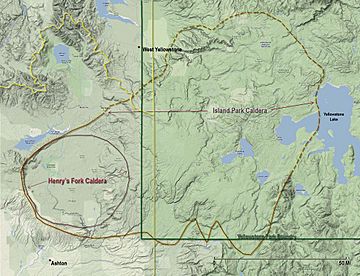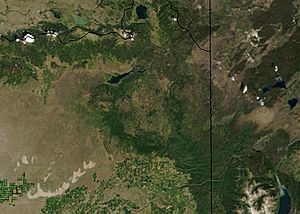Island Park Caldera facts for kids
Quick facts for kids Island Park Caldera |
|
|---|---|

Diagram of Island Park and Henry's Fork Caldera
|
|
| Highest point | |
| Elevation | 2,805 m (9,203 ft) |
| Geography | |
| Location | Fremont County, Idaho, US |
| Geology | |
| Mountain type | Caldera |
| Last eruption | 2.1 myr |

The Island Park Caldera is a huge, bowl-shaped area in Idaho and Wyoming, USA. It's one of the biggest calderas in the world. A caldera is like a giant crater that forms when a volcano erupts and then collapses. This one is about 80 kilometers (50 miles) long and 65 kilometers (40 miles) wide.
Contents
What is the Island Park Caldera?
The Island Park Caldera was created by a massive volcanic eruption. This "super-eruption" happened about 2.1 million years ago. It was incredibly powerful. It produced about 2,500 times more ash than the big 1980 eruption of Mount St. Helens.
The Huckleberry Ridge Tuff
The ash from this eruption is called the Huckleberry Ridge Tuff. You can find this ash spread across a huge area. It reached from southern California all the way to the Mississippi River near St. Louis. This shows just how enormous the eruption was.
The Henry's Fork Caldera Inside
Inside the older Island Park Caldera, there is a smaller, younger caldera. This one is called the Henry's Fork Caldera. It's the one you can see most clearly today.
How Henry's Fork Caldera Formed
The Henry's Fork Caldera formed about 1.3 million years ago. This happened during another large eruption. That eruption produced more than 280 cubic kilometers (67 cubic miles) of material. The ash from this event is known as the Mesa Falls Tuff.
Comparing the Two Calderas
The two calderas share the same edge on their western sides. However, the Island Park Caldera is much larger and more oval-shaped. It even stretches into Yellowstone National Park. Sometimes, the Island Park Caldera is also called the First Phase Yellowstone Caldera or the Huckleberry Ridge Caldera.
The Snake River Plain and Volcanic Features
To the southwest of the caldera lies the Snake River Plain. This flat area was formed by many older calderas. These calderas mark the path of the Yellowstone hotspot. A hotspot is a very hot spot deep inside the Earth that melts rock and causes volcanoes.
Features of the Plain
The Snake River Plain is a low area that sinks over time. This happens because of the weight of all the volcanic rocks that formed it. The Snake River winds its way through this plain. You can see other cool volcanic features here, such as the Menan Buttes. There's also the Big Southern Butte, and areas like Craters of the Moon. Other interesting spots include the Wapi Lava Field and Hell's Half Acre.
Exploring the Island Park Area
The calderas are located in an area known as Island Park. This region is famous for its beautiful nature. You'll find thick forests, large springs, and clear streams. There are also waterfalls, lakes, ponds, and marshes.
Activities and Wildlife
Island Park is a great place for wildlife viewing. It's also popular for fishing. During winter, snowmobiling and Nordic skiing are favorite activities. Harriman State Park is located right inside the caldera. From some spots in the caldera, you can even see the tall peaks of the Teton Range to the southeast.

